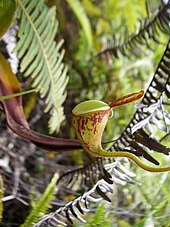Nepenthes ampullaria
| Nepenthes ampullaria | ||||||||||||
|---|---|---|---|---|---|---|---|---|---|---|---|---|

Nepenthes ampullaria |
||||||||||||
| Systematics | ||||||||||||
|
||||||||||||
| Scientific name | ||||||||||||
| Nepenthes ampullaria | ||||||||||||
| Jack |
Nepenthes ampullaria is a carnivorous plant belonging to the genus pitcher plants ( Nepenthes ). It was founded in 1819 by Dr. William Jack first described. Its specific epithet ampullaria isborrowed fromthe Latin ampullarius for "bottle maker" and an allusion to the shape of the jugs.
description
Vegetative characteristics
Nepenthes ampullaria is a perennial , evergreen shrub , climbing its instincts and become woody with age. Numerous new shoots sprout from the wood , but they form small, compact rosettes and only begin to climb after a long time. In Nepenthes ampullaria there are two leaf shapes : Climbing Alttriebe form alternating constant, elliptical leaves of up to 20 cm length from. Their surface is matt glossy. New shoots appearing from the wood, on the other hand, form compact, almost triangular leaves with a smooth, glossy surface that form a compact rosette.
The pitchers of Nepenthes ampullaria usually do not show pronounced dimorphism . The typical floor jugs are box-shaped and reach a height of 12 cm. The peristome is very wide, the narrow, elliptical jug lid stands vertically upwards or even backwards. The two wing strips are expansive and fan-shaped. The extremely rare air cans appear, if at all, on very old, climbing shoots. They are funnel-shaped and have no pronounced wing strips. They remain significantly smaller than the floor pitchers.
The diet of the plant, which differs from most species of the genus, is interesting: only a certain part consists of insects, the greater part consists of parts of organic matter that fall from above. This includes droppings from animals and birds as well as falling parts of plants.
Flower and seeds
The flowers of Nepenthes ampullaria are sexually dioecious ( dioecious ) and appear on panicles up to 40 cm long . They have four petals from reddish to olive brown in color.
Home / origin
Nepenthes ampullaria is native to Thailand , Indonesia , Malaysia and New Guinea . It grows there at an altitude of up to 1200 meters in swampy forest areas.
useful information
On an expedition in 1985-1986 in the Malay lowland researchers were on small black crabs the way Geosesarma malayanum attentive, who live temporarily in the cans. Certain spiders such as B. Thomisus nepenthiphilus and Misumenops nepenthicola also live in the jugs and even dare to fish out victims floating on the surface of the digestive fluid in order to eat them themselves. On Borneo , the smallest frog in the Old World , the pea-sized Microhyla nepenthicola , lays its eggs on the edge of the pitchers. The hatching tadpoles fall into the pitchers and grow in the digestive fluid.
Nepenthes ampullaria as an ornamental plant
Nepenthes ampullaria is a popular collector plant. It has also been crossed with numerous other species. The best-known hybrid is Nepenthes x hookeriana (developed from Nepenthes ampullaria and Nepenthes rafflesiana ), which has been available as a pot plant in flower shops for some time and is considered to be much more robust than the pure species.
literature
- Helmut Genaust: Etymological dictionary of botanical plant names. 3rd, completely revised and expanded edition. Birkhäuser, Basel et al. 1996, ISBN 3-7643-2390-6 .
Web links
- Nepenthes ampullaria - description (English and Latin, very detailed)
- Nepenthes ampullaria at www.fleischfressendepflanzen.de
- Nepenthes ampullaria in the endangered Red List species the IUCN 2006 Posted by: Clarke et al , 2000. Retrieved on 12 May, 2006.
Individual evidence
- ↑ Helmut Genaust: Etymological dictionary of botanical plant names. 3rd, completely revised and expanded edition. 1996, ISBN 3-7643-2390-6 , p. 58.
- ↑ Commensals
- ↑ Indraneil Das, Alexander Haas: New species of Microhyla from Sarawak: Old World's smallest frogs crawl out of miniature pitcher plants on Borneo (Amphibia: Anura: Microhylidae). In: Zootaxa . 2571, 2010, pp. 37-52 .

